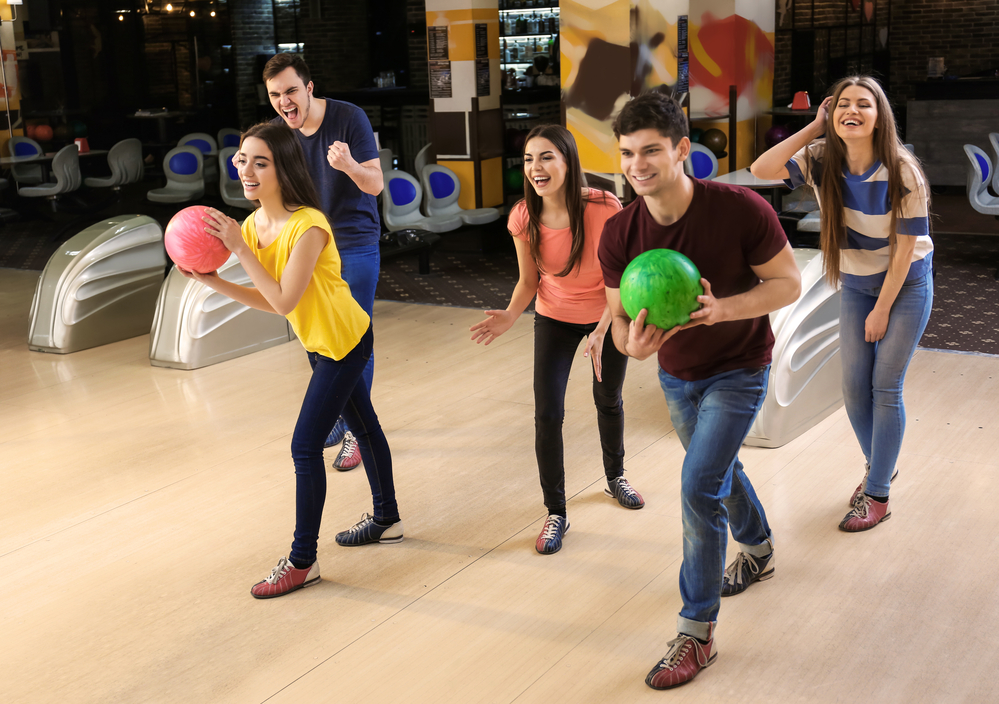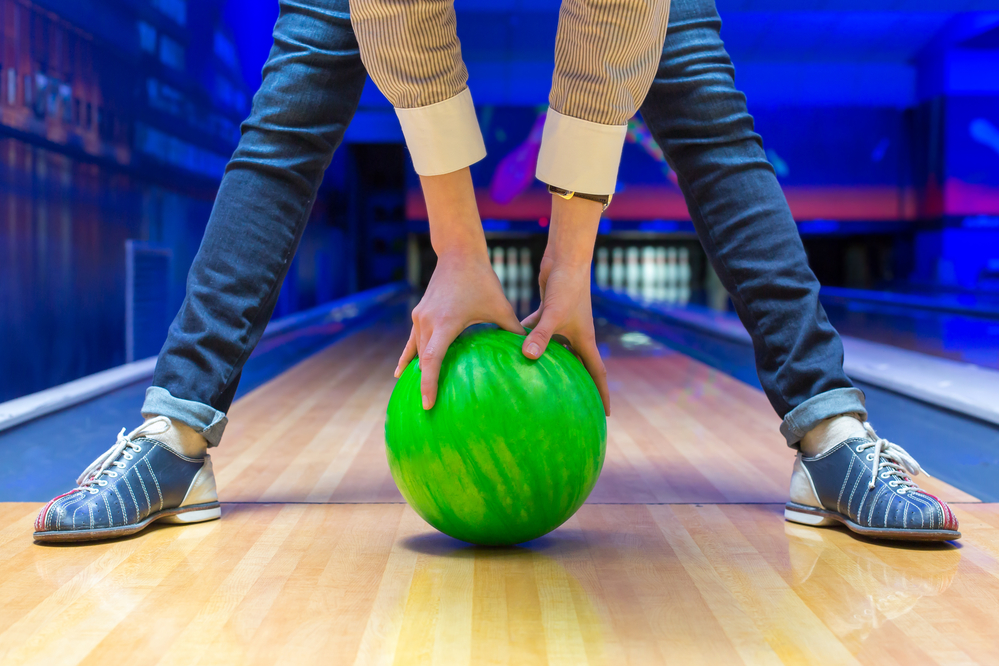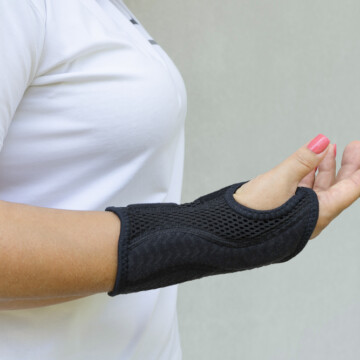
In the world of bowling, there is a controversial bowling style that is slowly but surely taking the sport by storm.
Two-handed bowling is the new style of release that utilizes both hands to guide the bowling ball into a powerful throw with high revs (revolutions or rotations of the ball around its axis) and powerful hooks.
While the throw itself does not increase the power generated using the technique, the form itself helps smooth out the transition between forms and deliver a more balanced throw.
In order to become a successful two-handed bowler, there will be some significant obstacles in your way.
Mastering this technique will take time, practice and patience. In order to gain skill in this form, you cannot just simply play in a league and expect to see results.
You will almost certainly need to dedicate extra time and money to learn how to throw two-handed. The payoff of your patience could well be worth it though, since this style of throwing is known to generate significantly more spin on throws, causing controversial viewpoints of its authenticity in the bowling community.
- Hammer Black Widow Legend Bowling Ball
- Brunswick Rhino Bowling Ball
- Brunswick Tzone Deep Space Bowling Ball (Spare Ball)
For complete newbies, I recommend that you start with the Hammer Black Widow Legend bowling ball. My wife and a couple of friends own this ball and it's simply fantastic.
Contents
What Is Two Handed Bowling?
The common practice of delivery in the sport of bowling is to use one hand to toss a ball down a sixty-foot wooden lane, with the goal being to knock down the ten pins at the opposite end (preferably in one throw).
Now in two-handed bowling, decades of practice and technique are thrown out the window as both hands are used to deliver the bowling ball into a powerful spin toss.
Instead of using one hand to aim, spin and release a two-handed bowler will use their non-dominant hand to cradle the front of the ball a to help stabilize and support the ball during the backswing.
As the ball is moved forward, the supporting hand is also utilized to guide the ball and generate more spin as the throw is executed.
Due to the use of two hands, more spin is usually generated naturally through the throw. (Note: The second hand is not used to add more spin to the throw but rather to support the bowler’s throw. The extra spin is created naturally as the two-handed throw is executed.)
Key Takeaways
- Two-Handed Bowling Technique: This technique emphasizes using both hands to guide the ball, leading to higher revs and powerful hooks. It requires practice and dedication and is recognized for generating more spin, challenging traditional one-handed bowling norms.
- Influential Figures: Australian bowler Jason Belmonte and Finnish bowler Osku Palermaa have been pivotal in popularizing two-handed bowling since its introduction around 2009, showcasing its effectiveness and stirring controversy within the professional bowling community.
- Technique Components: Essential elements include a proper stance with slightly bent knees and a forward-tilted spine, a four to five-step approach with strategic positioning, and a unique grip and swing emphasizing control and power during the release next to the ankle.
- Recommended Bowling Balls: For two-handed bowlers, balls like the Hammer Black Widow Legend and Brunswick Rhino are suggested due to their suitability for generating the necessary spin and control, with the Hammer Black Widow Legend being an excellent start for beginners.
- Controversy and Acceptance: While two-handed bowling faced skepticism and was deemed controversial for potentially offering an unfair advantage, it has been officially recognized as a legal technique by bowling associations, marking it as an evolution in the sport rather than a form of cheating.
When Did Two-Handed Bowling Start?

Considering that the game of bowling is thousands of years old, two-handed bowling is a baby technique compared to the rest of the game.
This style of throwing appeared in the American professional bowling community around the year 2009.
Over the course of the following years, two-handed bowling has slowly but surely gained a steady following due to its supportive hold and high generated spin.
An Australian by the name of Jason Belmonte is seen as the forefather of this innovative technique, his unique style of throwing generating quite the controversy in the professional bowling community.
Another famous two-handed bowler that is making a name for himself in the world of bowling is Osku Palermaa, a Finnish bowler who has been steadily rising in bowler leagues around the world.
These two bowlers are some of the key forces in getting two-handed bowling recognized as a viable stance and throw, though there are many who see this style as a disease to the sport they love so much.
How Does Two-Handed Bowling Work?
In order for a bowler to successfully pull off two-handed bowling, there are several key stance points that must come together cohesively. Two-handed bowlers generate their power and drive through techniques used in their stance, approach, and throw.
By utilizing these key factors together they are able to generate smoother throws with powerful spins.
Stance:
In order to accurately achieve a two-handed throw, bowlers will need to make sure they are in the proper form before moving forward. With two-handed bowling, you can find some similarities to one-handed bowling, parts of the initial stance are one of them.
To start off you should have your knees slightly bent and relaxed, your feet placed on the proper boards for your aiming marks. Your ball should be about waist high and your spine should be tilted about five to ten degrees forward.
As you shift through your approach your spine may tilt forward some more, but the degree range varies on the bowler.
Approach:
In the two-handed approach, a bowler will generally take four to five steps before their release. How big these steps are taken will vary depending on the length of a bowler’s stride but the pace and technique should generally be the same.
During the initial approach, a two-handed bowler will take two timed steps as if they were bowling one-handed, this helps with pacing and sets the bowler up for the rest of their approach.
On the second step, the bowler should also step to the left if they are right-handed or to the right if they are left-handed, it all depends on your dominant hand and where you are aiming. This second step is setting you up to walk around your swing and smooth out the technique.
At the third/fourth step the bowler should utilize what are called ‘skip steps’. These steps look like little hops or skips and should cover short distances. Your final step (which could be your fourth or fifth) should then fall into a very important slide step.
This step needs to be out longer and farther than if you were making the final step of a one-handed delivery.
Two-handed bowlers use this last slide step to achieve a lot of forward spine tilt without running the risk of face-planting on the floor, thus generating more power and spin while avoiding an opening for your buddies to poke fun of you.
The Two-Handed Bowling Throw
Grip:
When talking about a bowler’s throw - grip, swing, and release are generally included in the category. By combining these important aspects of a bowler’s game, players can generate powerful throws that can be balanced with well-placed technique.
When using the two-handed bowling technique a bowler needs to focus on several things with their grip. To start off the bowler will need to form a sort of cradle with their hands as they hold their ball before adjusting their grip to suit their needs.
There are different styles of gripping out there when it comes to two-handed throwing, some professionals choose to use their thumb with their grip and some forgo the thumb and instead choose to cradle the ball completely in their palm.
Once you have your thumb situation figured out, look at how you are placing your non-dominant hand.
How and where you place this hand affects how the ball is going to react at your initial release, so make sure you practice hand placement before a big tournament and have a good solid idea on what reactions you can get.
Swing:
The swing of the bowling ball is key with any style. During the swing, bowlers work to generate power in order to toss their ball down a sixty-foot lane. How far you swing back usually has a direct relation in how powerful your throw is.
For example, a back swing past the shoulder blades will have a lot of power. Unfortunately the same can be said with the aiming of your ball, the more powerful the throw the less control you have of the ball’s trajectory.
Many bowlers spend hours of practice perfecting their throws, working on creating powerful tosses with accurate aiming techniques. Even still these throws are not one-hundred percent effective and points are lost.
With two-handed bowling, the swing of the ball is a little different. Instead of swinging your arm back like a pendulum you keep the ball cradled close to your chest, angling upward and forward to generate power.
The non-dominant hand should stay on the ball until the point of release and your elbow should only uncork right before the release. This is done to hopefully add more speed and revolutions to your ball as you throw it down the lane.
Release:
The release of a two-handed throw should happen next to your ankle to generate leverage and, therefore, more power.
It is very important that you do not try to create more spin at this point using your non-dominant hand; the spin will come naturally if you have executed your stance and throw correctly.
Where your non-dominant hand rests before the release also depends on how you want your ball to react. By experimenting with your hand placement and releases, you should be able to make the ball react in different ways that can help you get an edge on your game.
| Aspect | One-Handed Bowling | Two-Handed Bowling |
|---|---|---|
| Introduction | Traditional, widely practiced | Emerged around 2009, gaining popularity |
| Key Figures | N/A | Jason Belmonte, Osku Palermaa |
| Technique | Utilizes one hand for guiding and spinning the ball | Uses both hands to increase revs and control |
| Ball Type | Varies, less emphasis on specific types | Recommends reactive resin, urethane, and specific models like Hammer Black Widow Legend |
| Pros | Established, well-documented technique | Generates more spin, potentially more powerful |
| Cons | Limited spin compared to two-handed | Requires more practice, not as traditional |
| Legality | Universally accepted | Initially controversial, now accepted by Professional Bowlers Association and others |
| Recommended for | Players comfortable with traditional play | Bowlers seeking to add spin and try innovative techniques |
What's the Best Bowling Ball for Two-Handed Bowlers?
For two-handed bowlers, the type of bowling ball they use can vary based off of the conditions of the lane. Just like one-handed bowling, two-handed bowling is affected by the oil patterns laid out on the lane and the corresponding fluctuation of friction they bring.
That being said, there are different types of bowling balls out there that are made specifically for two-handed bowlers. A good place to start would be an entry-level resign coverstock with a grit between 2000 and 3000.
Make sure this bowling ball also is weighted for two-handed bowling since the ball needs to react in a different way from the customary one-handed bowling.
Once you have a good reference point you can modify your balls as you go based on the needs that arise from your own personal style.
For beginners, I recommend the Hammer Black Widow Legend bowling ball. Click here to read the latest reviews of the Hammer Black Widow Legend bowling ball on Amazon.
What Are the Pros and Cons of Two-Handed Bowling?
When deciding if you would like to try your luck at two-handed bowling it is important to understand that like with all techniques, two-handed has both its positive and its negative benefits.
With two-handed bowling, the versatility of the throw may decrease due to the nature of the throw. While this lack of variation can be overcome with dedicated practice it is still a struggle for some who have been using the technique for years.
Two-handed bowling is also new to the bowling world so the prior knowledge on how to master the technique is not so readily available.
Mastering two-handed bowling will also take a lot more practice than many one-handed techniques, you will probably even have to put in the extra time and money for supplementary practices as you work on learning the skill.
Now while mastering two-handed bowling will definitely take a lot of hard work, the reward can be well worth the lighter wallet and sore muscles.
Two-handed throws, when executed correctly, generate powerful, smoother throws that blast through the racks and scatter pins in their wake. In fact, there is such a difference in power and spin that many are calling two-handed cheating due to an unfair advantage!
Is Two-Handed Bowling Cheating?
When two-handed bowling first appeared on the scene there was a large outcry from the bowling community on whether or not this style was a legal form of the game.
Due to this outcry, large-scale bowling associations from around the world, America’s own Professional Bowlers Association included, studied how the technique fits into the rules laid out decades ago.
In their findings, they saw that two-handed bowling did not go against any regulations or break any rules with its new style and concluded that the technique was a legal form of gameplay.
Even with this finding though there are many that hate the two-handed style, claiming it is a disease that is attacking the form of bowling in its entirety.
However, if you were to look back at the history of bowling, both the formal history as well as the speculations, you’ll see that the game itself has changed and evolved drastically throughout the thousands of years it has been around!
Decades ago bowling was a game of throwing a hand-sized ball down one plank of wood and we changed it and modified it to the game we know today. To see two-handed bowling as a new twist on bowling is fine, to call it cheating just because it is different is not.
Two-handed bowling is not a form of cheating in the world of bowling, but rather an evolution in the game that has happened in our lifetime.
So while two-handed bowling may seem like cheating to some that really couldn’t be farther from the truth. Two-handed bowlers work just as hard as one-handed bowlers mastering their style and forms, bowling extra long hours in order to get their throws just right.
Related Articles
Two-handed bowling, a technique that has revolutionized the bowling game, refers to a method where the bowler uses both hands to guide the ball forward, enhancing revs and control. This approach, contrasted with traditional one-handed bowlers, requires a nuanced understanding of arm swing, ball speed, and the bowling approach. The United States Bowling Congress and PBA bowlers acknowledge this style for its strategic advantage in precisely knocking down all the pins.
When selecting bowling balls, new two-handed bowlers should consider the differences among plastic, reactive resin, and urethane bowling balls to match their style and the bowling alley's lane conditions. Additionally, mastering spare shooting and understanding the importance of bowling shoes add to a bowler's technique. This article aims to offer bowling tips and critical points that equip other bowlers with the knowledge to adopt the two-handed technique or better understand its impact on the sport, promoting a broader appreciation for the diverse strategies within the bowling community.
Kira Byrd, a Certified Fraud Examiner, holds a B.S. in Accounting from the University of Alabama at Birmingham. With a passion for bowling from her childhood, Kira has poured her expertise and personal experiences into creating and nurturing Bowling For Beginners. Kira's mission is to meet new bowlers where they are and guide them toward consistently achieving higher scores. With a focus on skill development and strategic techniques, she empowers readers to take control of their game and unlock their true potential.
Bowling For Beginners embodies strict editorial integrity, ensuring reliable and unbiased information. Kira's commitment to delivering valuable insights and practical strategies is reflected in every article. Here's an explanation of our editorial policy and how we get money.





